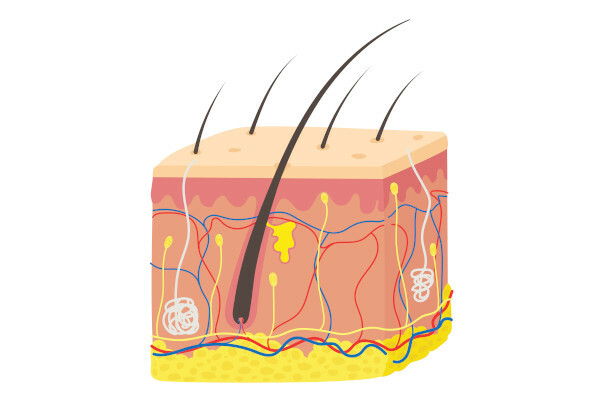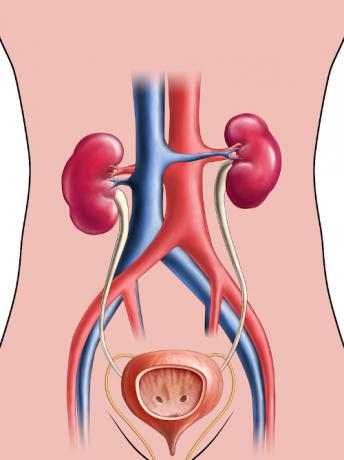You human body organs are structures formed by different fabrics and that they work in a coordinated way to ensure that different processes take place in our bodies. Organs are grouped into different systems, which make up the human organism. In this text we will talk a little more about the following organs: skin, heart, blood vessels, brain, trachea, pharynx, lungs, esophagus, stomach, small intestine, large intestine, liver, kidney, bladder, testicle, ovary, uterus.
Read too: Human body - levels of organization, cells and tissues
Organs of the human body

organs are structures formed by a group of tissues, formed by cells. The bodies that work together to carry out a specific task form what are called systems. The digestive system, for example, is made up of organs that work for the digestion of food and the absorption of nutrients necessary for the organism to function. Next, we will talk about different organs, separating them according to the system to which each one of them belongs.
Organs of the integumentary system

- Skin: it is the largest organ in the human body, weighing about 3 kg. It consists of two layers: the epidermis, consisting of epithelial tissue, and the dermis, formed by connective tissue. The skin acts in different processes, being related to the perception of sensations, such as pain and temperature, protection against external agents, thermoregulation, among others.
Read too: Skin cancer - a very common type of neoplasm in the population
Organs of the cardiovascular system

- Heart: is an organ of the Cardiovascular system that guarantees the pumping of the blood for different parts of our body. It presents involuntary contractions, being basically formed by striated cardiac muscle. The human heart has four cavities: two atria and two ventricles.
- Blood vessels: they are where the blood circulates in our body. The three basic types of blood vessels are the arteries, veins and capillaries. Arteries ensure that blood is taken from the heart to various parts of the body. The veins, in turn, promote the return of blood to the heart. Capillaries are thin vessels that allow gas exchange.
Do not stop now... There's more after the advertising ;)
Organs of the Nervous System

- Brain: is part of central nervous system and stands out for being the largest portion of the brain. It can be divided into two hemispheres, the right and the left. The human brain is related to processes such as our capacity for memory, language, learning and the integration of sensory information.
Organs of the respiratory system

- Trachea: is a cylindrical tube formed by rings of hyaline cartilage that have a C shape. The trachea is covered by a ciliated epithelium with mucus-secreting cells. Cell cilia help to sweep away particles that can enter through the respiratory system at the moment of inspiration.
- Lungs: they are cone-shaped organs that appear as a spongy mass, containing thousands of alveoli. It is in the lungs, more precisely in the alveoli, that gas exchange takes place.
See more: What is in-breath and out-breath?
Organs of the digestive system

- Esophagus: it is a muscular organ that ensures that the bolus of food is taken from the pharynx to the stomach. The presence of unstriated muscle, which performs peristaltic contractions, allows the bolus to be taken to the stomach.
- Stomach: is an organ that stands out for being the most dilated portion of the digestive system. In this region, the secretion of the so-called gastric juice is observed, which promotes part of the chemical digestion of food. In gastric juice, it is found hydrochloric acid and pepsin, an enzyme responsible for breaking down proteins.
- Small intestine: it is the largest compartment of the digestive system, reaching more than 6 meters. It can be divided into three parts: duodenum, jejunum and ileum. In the small intestine, most of the digestion process takes place, thanks to the action of secretions from the organ itself, coming from the pancreas (pancreatic juice) and the liver (bile). In the small intestine, the absorption of nutrients also takes place, and this process is very efficient due to a lot of folds in its lining (villi) and projections in its cells (microvilli).
- Large intestine: it is formed by the colon, cecum and rectum. Unlike the small intestine, this intestine is only about 1.5 m long. The large intestine is responsible for water reabsorption and the formation of fecal bolus.
- Liver: is gland accessory of the digestive system and stands out for being the second largest organ in the human body, second only to the skin. The liver is responsible for secreting bile and also acts in other processes, such as glycogen storage and detoxification.
Urinary System Organs

- Kidneys: are two bean-shaped organs, which are related to blood filtration and urine formation. Urine is formed more precisely in the nephrons, which are the functional units of the kidney.
- Bladder: it is an organ that guarantees the storage of urine until it is eliminated to the external environment. The bladder's storage capacity is 700 ml to 800 ml, however, voiding stimuli start before the bladder reaches its maximum capacity.
Read too: Urinary tract infection - disease caused mainly by bacteria
Organs of the reproductive system

- Testicles: are exclusively male organs responsible for the formation of male gametes (sperm). In addition, the testicles produce testosterone, a hormone related, among other functions, to the development of secondary male characteristics.
- ovaries: are the female organs responsible for the formation of female gametes (oocytes). They are also responsible for the synthesis of two hormones: estrogen and progesterone. Both estrogen and progesterone are related, among other functions, to the regulation of menstrual cycle.
- Uterus: it is also an exclusively female organ, where the baby develops. The uterus is a muscular organ, thus ensuring its expansion during pregnancy. Internally it has a richly vascularized layer that is partially lost during the menstruation process.
By Vanessa Sardinha dos Santos
Biology teacher
Would you like to reference this text in a school or academic work? Look:
SANTOS, Vanessa Sardinha dos. "Organs of the human body"; Brazil School. Available in: https://brasilescola.uol.com.br/biologia/orgaos-do-corpo-humano.htm. Accessed on June 27, 2021.

